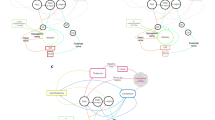Summary
Changes in the distribution of3H-quinuclidinylbenzilate (3 H-QNB),3 H-acetylcholine (3 H-ACh) and3 H-alpha-bungarotoxin (alpha-BTx) binding sites were studied with the use of quantitative in vitro autoradiography in the L4–L6 segments of rats 7 days after ventral L4–L6-rhizotomies and 24 hours after ligation of the dorsal roots L4–L6. The changes in the binding sites of these ligands and of3 H-etorphine binding sites were also studied in the dorsal roots of the rats operated with dorsal root ligation and in the sciatic nerves (around a ligature) in the rats operated with ventral rhizotomy. After ventral rhizotomy3 H-QNB binding sites in the ipsilateral motor neuron area were decreased by about 25% from 100±5 to 73±5 fmol/mg wet weight. After dorsal root ligation3 H-QNB binding sites in the ipsilateral posterior horn were reduced by about 30% from 91±5 to 64±7 fmol/mg wet weight. No significant changes in the binding of the other cholinergic ligands in the spinal cords were observed after the operations. In the dorsal root3 H-alpha-Btx and3 H-etorphine binding sites were higher on the distal side of the ligation (3.5±0.8 and 14±4 fmol/mg wet weight, respectively) than on the proximal side (0.7±0.5 and 2.4±1.2 fmol/mg wet weight, respectively).The same level of3 H-ACh (total, muscarinic and nicotinic) binding was observed on both sides of the ligation. In the sciatic nerve3 H-QNB and total, muscarinic and nicotinic ACh binding sites were higher on the proximal side of the ligation than on the distal side. Except for a small emergence of muscarinic-ACh binding distally to the ligation there were no changes in the number of binding sites in the sciatic nerve after the ventral rhizotomy.
Muscarinic antagonist binding sites are probably located on the perikarya of the motor neurons and presynaptically on the primary afferents in the posterior horn and in the dorsal root. Cholinergic agonist binding sites in the spinal cord seem less sensitive to axonal damage than antagonist binding sites. Cholinergic and opioid receptors in peripheral nerves are transported in both anterograde and retrograde directions and their origin seems to be the dorsal root ganglion.
Similar content being viewed by others
References
Atweh SF, Murrin LC, Kuhar MJ (1978) Presynaptic localization of opiate receptors in the vagal and accessory optic systems: an autoradiographic study. Neuropharmacology 17: 65–71
Barber RP, Phelps PE, Houser CR, Crawford GD, Salvaterra PM, Vaughn JE (1984) The morphology and distribution of neurons containing choline acetyltransferase in the adult rat spinal cord: an immunochemical study. J Comp Neurol 229: 329–346
Gillberg P-G, Wiksten B (1986) Effects of spinal cord lesions and rhizotomies on cholinergic and opiate receptor binding sites in rat spinal cord. Acta Physiol Scand 126: 575–582
Gulya K, Kasa P (1984) Transport of muscarinic cholinergic receptors in the sciatic nerve of rat. Neurochem Int 6: 123–126
Hebel R, Stromberg MW (1976) Anatomy of the laboratory rat. Williams and Wilkins, Baltimore
Laduron PM (1984) Axonal transport of receptors: coexistence with neurotransmitter and recycling. Biochem Pharmacol 33: 897–903
Laduron PM, Janssen PFM (1986) Impaired axonal transport of opiate and muscarinic receptors in streptozocin-diabetic rats. Brain Res 380: 359–362
Lamotte C, Pert CB, Snyder SH (1976) Opiate receptor binding in primate spinal cord: distribution and changes after dorsal root section. Brain Res 112: 407–412
Messer WS, Hoss W (1987) Selectivity of pirenzepine in the central nervous system. I. Direct autoradiographic comparison of the regional distribution of pirenzepine and carbamylcholine binding sites. Brain Res 407: 27–36
Ninkovic M, Hunt SP, Gleave JRW (1982) Localization of opiate and histamine H1-receptors in the primate sensory ganglia and spinal cord. Brain Res 241: 197–206
Ninkovic M, Hunt SP (1983) α-Bungarotoxin binding sites on sensory neurones and their axonal transport in sensory afferents. Brain Res 272: 57–69
Wamsley JK, Zarbin MA, Kuhar MJ (1981) Muscarinic cholinergic receptors flow in the sciatic nerve. Brain Res 217: 155–161
Zarbin MA, Wamsley JK, Kuhar MJ (1982) Axonal transport of muscarinic cholinergic receptors in rat vagus nerve: high and low affinity agonist receptors move in opposite directions and differ in nucleotide sensitivity. J Neurosci 2: 934–941
Zieglgänsberger W, Reiter C (1974) A cholinergic mechanism in the spinal cord of cats. Neuropharmacology 13: 519–527
Author information
Authors and Affiliations
Rights and permissions
About this article
Cite this article
Gillberg, P.G., Askmark, H. Changes in cholinergic and opioid receptors in the rat spinal cord, dorsal root and sciatic nerve after ventral and dorsal root lesion. J. Neural Transmission 85, 31–39 (1991). https://doi.org/10.1007/BF01244655
Received:
Accepted:
Issue Date:
DOI: https://doi.org/10.1007/BF01244655




